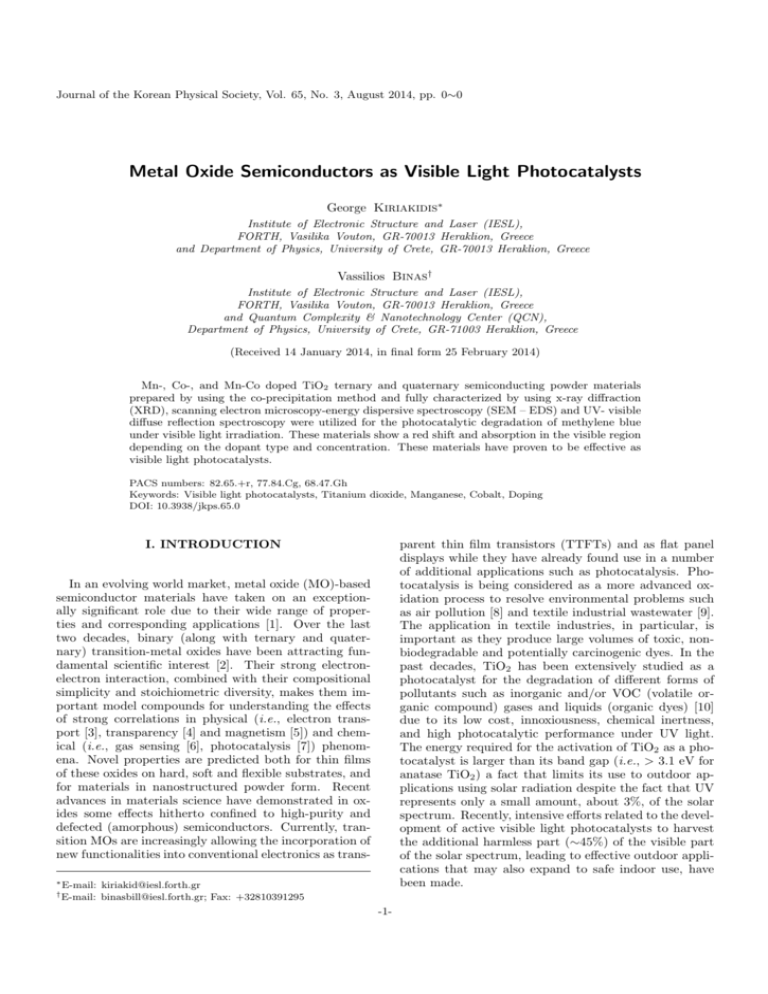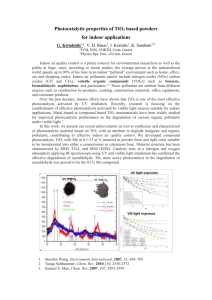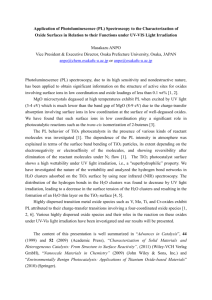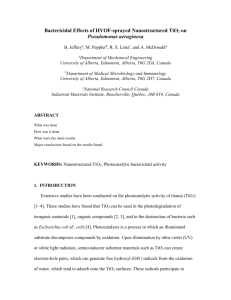Metal Oxide Semiconductors as Visible Light Photocatalysts
advertisement

Journal of the Korean Physical Society, Vol. 65, No. 3, August 2014, pp. 0∼0 Metal Oxide Semiconductors as Visible Light Photocatalysts George Kiriakidis∗ Institute of Electronic Structure and Laser (IESL), FORTH, Vasilika Vouton, GR-70013 Heraklion, Greece and Department of Physics, University of Crete, GR-70013 Heraklion, Greece Vassilios Binas† Institute of Electronic Structure and Laser (IESL), FORTH, Vasilika Vouton, GR-70013 Heraklion, Greece and Quantum Complexity & Nanotechnology Center (QCN), Department of Physics, University of Crete, GR-71003 Heraklion, Greece (Received 14 January 2014, in final form 25 February 2014) Mn-, Co-, and Mn-Co doped TiO2 ternary and quaternary semiconducting powder materials prepared by using the co-precipitation method and fully characterized by using x-ray diffraction (XRD), scanning electron microscopy-energy dispersive spectroscopy (SEM – EDS) and UV- visible diffuse reflection spectroscopy were utilized for the photocatalytic degradation of methylene blue under visible light irradiation. These materials show a red shift and absorption in the visible region depending on the dopant type and concentration. These materials have proven to be effective as visible light photocatalysts. PACS numbers: 82.65.+r, 77.84.Cg, 68.47.Gh Keywords: Visible light photocatalysts, Titanium dioxide, Manganese, Cobalt, Doping DOI: 10.3938/jkps.65.0 parent thin film transistors (TTFTs) and as flat panel displays while they have already found use in a number of additional applications such as photocatalysis. Photocatalysis is being considered as a more advanced oxidation process to resolve environmental problems such as air pollution [8] and textile industrial wastewater [9]. The application in textile industries, in particular, is important as they produce large volumes of toxic, nonbiodegradable and potentially carcinogenic dyes. In the past decades, TiO2 has been extensively studied as a photocatalyst for the degradation of different forms of pollutants such as inorganic and/or VOC (volatile organic compound) gases and liquids (organic dyes) [10] due to its low cost, innoxiousness, chemical inertness, and high photocatalytic performance under UV light. The energy required for the activation of TiO2 as a photocatalyst is larger than its band gap (i.e., > 3.1 eV for anatase TiO2 ) a fact that limits its use to outdoor applications using solar radiation despite the fact that UV represents only a small amount, about 3%, of the solar spectrum. Recently, intensive efforts related to the development of active visible light photocatalysts to harvest the additional harmless part (∼45%) of the visible part of the solar spectrum, leading to effective outdoor applications that may also expand to safe indoor use, have been made. I. INTRODUCTION In an evolving world market, metal oxide (MO)-based semiconductor materials have taken on an exceptionally significant role due to their wide range of properties and corresponding applications [1]. Over the last two decades, binary (along with ternary and quaternary) transition-metal oxides have been attracting fundamental scientific interest [2]. Their strong electronelectron interaction, combined with their compositional simplicity and stoichiometric diversity, makes them important model compounds for understanding the effects of strong correlations in physical (i.e., electron transport [3], transparency [4] and magnetism [5]) and chemical (i.e., gas sensing [6], photocatalysis [7]) phenomena. Novel properties are predicted both for thin films of these oxides on hard, soft and flexible substrates, and for materials in nanostructured powder form. Recent advances in materials science have demonstrated in oxides some effects hitherto confined to high-purity and defected (amorphous) semiconductors. Currently, transition MOs are increasingly allowing the incorporation of new functionalities into conventional electronics as trans∗ E-mail: † E-mail: kiriakid@iesl.forth.gr binasbill@iesl.forth.gr; Fax: +32810391295 -1- -2- Journal of the Korean Physical Society, Vol. 65, No. 3, August 2014 Doping with transition-metal oxides is a promising way to improve photocatalytic efficiency in the visible range by taking into account that transition-metal atoms can exist in various oxidation states. A number of research groups have used different methods (such as solgel, co-precipitation, impregnation, spattering, etc) to introduce transition metals such as V, Cr, Mn, Fe, Co, Ni, Cu, Zr, Nb, Mo, Ru, Ag, Au and Pt into TiO2 [7, 10–12]. The introduction of transition-metal cations into TiO2 is believed to be able to change the coordination environment of Ti in the lattice and to modify the electronic structure of TiO2 , which may lead to a shift in the light absorption edge from UV towards the visible light region. In the present work, we focus on the photocatalytic efficiency of metal-oxide semiconductors doped with transition metals, which are capable of absorbing and being activated under visible light irradiation. We synthesized Mn-, Co- and Mn-Co doped TiO2 nanoparticles using the co-precipitation method and report on their photocatalytic efficiencies. The morphology, the structure and the optical and the physical properties of the prepared metaloxide semiconductors (MOSs) were investigated by x-ray diffraction (XRD), scanning electron microscopy-energy dispersive spectroscopy (SEM – EDS), and UV-Vis spectroscopy. The photocatalytic efficiencies of the prepared doped MOs were evaluated based on the degradation of the organic dye methylene blue (MB) in water as a model reaction under black and visible light irradiation. II. EXPERIMENTS A co-precipitation method was used to prepare Mn-, Co- and Mn/Co (1:1) -doped TiO2 ternaries and quaternaries with dopant concentrations in solution of 0.1 wt%. Doped titanium dioxide was precipitated at pH ˜7 from an aqueous solution of TiOSO4 [titanium (IV) oxysulfate hydrate] by using as dopant Mn or Co or Mn/Co and by the addition of ammonia. After the suspension had been aged overnight, the precipitate was filtered and dried in air at 373 K. The residue was crushed to a fine powder and calcinated in a furnace at 973 K for 3 h. Powder X-ray diffraction patterns were collected on a Rigaku D/MAX-2000H rotating anode diffractometer (Cu Kα radiation) equipped with a secondary pyrolytic graphite monochromator operating at 40 kV and 80 mA over the 2θ collection range of 10 – 80◦ . The scan rate was 0.05◦ s−1 . The average crystal size (D in nm) of the nanoparticles was calculated from the line broadening of the X-ray diffraction peak according to the Scherrer formula as follows: D = kλ/βcosθ, where k is the Scherrer constant (∼0.9), λ is the wavelength of the X-ray radiation (1.54 Å for Cu Kα), β is the full width at half maximum (FWHM) of the diffraction peak measured at 2θ, and θ is the Bragg angle. The UV – visible diffuse reflectance spectra of the final powders were measured Fig. 1. (Color online) XRD patterns of Mn-, Co- and Mn/Co- doped TiO2 all in concentrations of 0.1 wt%. on a Perkin Elmer LAMBDA 950 system with BaSO4 as a reference standard. The band gaps were determined by plotting the Kubelka – Munk function. The surface morphology and an elemental analysis of the MOs were carried out using SEM and EDS spectroscopy on a JSM6390LV instrument. The powders were dispersed on a sample holder, gold-coated and viewed through an electron microscope. Photocatalytic degradation of MB was carried out at room temperature in the presence of black and visible light irradiation. Illumination was provided by two 18W Osram blue-black lights (Osram blue black light 18W L/W 73) or four 18-W visible lamps (Philips Master TL-D 18-W/840) placed on the top of a homemade environmental photocatalytic box at a distance of ∼25 cm from the suspension. The environmental box was also further equipped with two fans to keep the temperature stable. In a typical experiment, 100 mg of fabricated powder material was suspended in 100 ml of aqueous MB solution (10 ppm) in the presence of atmospheric oxygen at two different pH values (6 and 10). Prior to irradiation, the powders were well dispersed; the suspension was treated ultrasonically for 10 min, followed by stirring in the dark for 30 min to achieve adsorption equilibrium. Dye degradation was monitored using an Ultraviolet– Visible spectrophotometer (VARIAN Cary 50) by measuring the absorbance of the MB 664-nm (λmax for MB) characteristic line. III. RESULTS AND DISCUSSION The XRD patterns of Mn-, Co- and Mn-Co doped TiO2 (total dopant concentration in the solution was 0.1 wt %) calcinated at 700 ◦ C for 3 h are shown in Fig. 1. The peaks at 2θ values of 25.3, 37.6, and 48.2 correspond Metal Oxide Semiconductors as Visible Light Photocatalysts· · · – George Kiriakidis and Vassilios Binas -3- Table 1. Main Characterization results of Ti − M metal oxides. Sample Undoped TiO2 Mn − TiO2 Co − TiO2 Mn/Co − TiO2 dopant concentration wt % OR mole fraction − 0.1 0.1 0.1 d(101) 2θ Anatase crystal Size (D, nm) Indirect band gap (eV) 25.25 25.20 25.20 24.95 35.5 38.7 40.1 40.1 3.1 2.8 2.8 [1.55*] 2.8 [1.5*] *sub-band gap to the (101), (004), and (200) planes, respectively, and they are all anatase signature peaks. Doping with Mn and Co cations led to a small shift of the main (101) peak to a lower angle in comparison with the undoped anatase TiO2 , an indication of an increase in the lattice constant and the presence of dopant-induced lattice stress. In the case of Mn/Co-doped TiO2 , the positions of the (101), (004), and (200) diffractions were also shifted to smaller θ. In Table 1, these differences are listed. It should be noted that no obvious manganese- or cobalt-oxiderelated diffraction peaks were observed. The dependence of the anatase crystal size on the dopant incorporation is also depicted in Table 1. The anatase crystal size was found to be increased significantly by the incorporation of dopant ions into the lattice of TiO2 . Figure 2 shows the UV-VIS absorption spectra as a function of wavelength for the Mn-, Co- and Mn/Codoped TiO2 semiconductors. All the doped semiconductors exhibited an absorption edge in the visible light range (400 – 800 nm), Fig. 2(a). The incorporation of dopants led to a distinct decrease in the band-gap energy to below the value of 3.1 eV of the undoped TiO2 (Table 1). The absorption curves of the doped semiconductors were clearly shifted to lower energies and showed a significant sub-band-gap absorption with two absorption humps. The first was between 370 – 500 nm and the second between 470 – 800 nm. These two broad absorption humps are normally associated with d-d electronic transitions of Mn2+ and Co2+ in the octahedral coordination of Ti in the lattice [13, 14]. The band-gap energies (Eg) for all the samples were determined by using Kubenka-Munk plots as shown in Fig. 2(b) and Table 1. In the case of Co- and Mn/Co-doped TiO2 , a new subband-gap appears with a value of 1.6 eV while the broad peak around 650 nm is usually attributed to the Co2+ and the Co3+ species [15]. The new absorption shoulders of the doped TiO2 in the range of 400 – 800 nm are believed to be the reason for the enhanced overall photocatalytic activity within the visible range shown below. The textural features of the MOs were investigated with SEM, and representative images are shown in Figs. 3(a,b,c). No specific morphology changes were Fig. 2. (Color online) (a) UV- VIS absorption spectra as a function of wavelength for Mn-, Co-, and Mn/Co- doped TiO2 semiconductors, (b) Energy gaps calculated from a KubenkaMunk plots for Mn-doped TiO2 , Co-doped TiO2 and Mn/Co co-doped TiO2 in concentrations of 0.1 wt%. detected, but the spherically shaped particles of all MOs demonstrated some degree of agglomeration with diameters ranging from 0.1 to 40 µm. The photocatalytic efficiencies of Mn-, Co- and Mn-Co doped TiO2 were studied based on photo-degradation at -4- Journal of the Korean Physical Society, Vol. 65, No. 3, August 2014 Fig. 4. (Color online) Photocatalytic efficiency of MB degradation under black light irradiation of Mn-, Co-, and Mn/Co- doped photocatalysts for pH values (a) 10 and (b) 6. Fig. 3. (Color online) SEM images of Mn-, Co- and Mn/Co- doped TiO2 in concentration of 0.1 wt%. room temperature of the standard organic dye MB in a test reaction chamber under black and visible light irradiation. MB alone did not show any photo-degradation when irradiated by black or visible light. The photocatalytic efficiencies of Mn-, Co- and Mn/Co-doped TiO2 for MB photo-degradation under black light irradiation at two different pH conditions (10 and 6) are shown in Figs. 4(a) and (b) respectively. In both cases, the doped TiO2 showed a significant photocatalytic efficiency on the order of 60% under black light irradiation with its value remaining almost unchanged when the pH was increased from 6 to 10. When the suspension (doped TiO2 and MB) was irradiated with visible light (Figs. 5(a) and (b)), all doped TiO2 shown significant photocatalytic efficiency (about 60%) at pH = 6. However, when the pH was increased to 10, all doped TiO2 showed an improved photocatalytic efficiency of about 70%. Particularly for the case of Mn-doped TiO2 while at pH = 6 it had shown a photocatalytic efficiency of about 18% at pH = 10 the efficiency was increased to 56% (a significant 66% increase). Herrmann et al. [16] showed a corresponding increase in the adsorption of MB when the pH was increased from 3 to 9, a result that is in agreement with the influence of pH on the ionization state of TiO2 , because the adsorption of MB (cationic configuration) is favored in alkaline solutions. The kinetics of the photocatalytic degradation of MB was evaluated by applying the Langmuir – Hinshelwood model in which the photocatalytic activity of a semiconductor can be estimated through the equation lnCo /Ct = kt, where Co and Ct represent the concentrations of the organic pollutant at zero time and time t, and k is a rate constant for the reaction. Figures 6(a) and (b) show the kinetics (photo-degradation rate) of MB (pH = 10 and 6) under visible light irradiation in the presence of Mn-, Co- and Mn/Co-doped TiO2 . The photocatalytic degradation rate of MB was found to follow the Metal Oxide Semiconductors as Visible Light Photocatalysts· · · – George Kiriakidis and Vassilios Binas Fig. 5. (Color online) Photocatalytic efficiency of MB degradation under visible light irradiation of Mn-, Co-, and Mn/Co- doped photocatalysts for pH values (a) 10 and (b) 6. Table 2. Experimental values of the rate constant and the photocatalytic efficiency for Mn-, Co- and Mn/Co-doped TiO2 for the degradation of MB under visible light irradiation. Sample Mn − TiO2 Co − TiO2 Mn/Co − TiO2 pH 6 10 6 10 6 10 Visible light irradiation Photocatalytic Rate constant efficiency (%) (k, ×10−3 min−1 ) 18 1.27 54 3.84 50 3.59 69 5.92 58 4.68 62 4.89 first-order kinetic model. The first-order rate constants, k, were calculated from the slopes of the graphs of ln Co /Ct versus t for Mn-, Co- and Mn/Co-doped TiO2 and the results are listed in Table 2. As shown in this table, the rate constants for all materials increased with -5- Fig. 6. (Color online) Kinetic study of the oxidation of MB under visible irradiation of Mn-, Co- and Mn/Co- doped photocatalysts for pH values (a) 10 and (b) 6. increasing pH from 6 to 10, with corresponding values for of kM n = 3.84 × 10−3 min−1 , kCo = 5.92 × 10−3 min−1 and kM n/Co = 4.89 × 10−3 min−1 under visible light at pH = 10. IV. CONCLUSION In this work, anatase Mn-, Co and Mn/Codoped TiO2 semiconductor powder materials were synthesized using a co-precipitation method with particle sizes in the range between 35 – 40 nm. Optical measurements indicated a red shift and an absorption in the visible region that depended on the doping material. In the case of Co and Mn/Co dopants an extra sub-band gap was found to be present. The photocatalytic efficiencies of Mn, Co and Mn/Codoped TiO2 were found to be significantly higher under visible light as compared to black light irradiation. We conclude that these semiconductors can be applied to the degradation of a wide range of organic pollutants, thus contributing to an enhanced industrial wastewater -6- Journal of the Korean Physical Society, Vol. 65, No. 3, August 2014 treatment process with the distinct advantage of visiblelight activation over the conventional undoped TiO2 . ACKNOWLEDGMENTS This work was partially supported by the EU FP7 Programmes (FP7-REGPOT-2012-2013-1) under grant agreement no 316165 and FP7 IP “ORAMA” no 246334. REFERENCES [1] S. Ramanathan, Thin Film Metal-Oxides, ISBN: 978-14419-0663-2, (Springer, United States 2010). [2] H. H. Kung, Transition Metal Oxides: Surface Chemistry and Catalysis (Elsevier, Amsterdam, 1991). [3] J. A. Anta, Curr. Opin. Coll. Interf. Sci. 17, 124 (2012). [4] R. Martins, E. Fortunato, P. Barquinha and L. Pereira, Transparent Oxide Electronics (John Wiley & Sons, Ltd, Chichester, UK 2012). [5] J. M. D. Coey, M. Venkatesan and C. B. Fitzgerald, Nature Mater. 4, 173 (2005). [6] G. Kiriakidis, K. Moschovis, I. Kortidis and V. Binas, Vacuum 86, 495 (2012). [7] V. D. Binas, K. Sambani, T. Maggos, A. Katsanaki and G. Kiriakidis, Appl. Catal. B: Environ. 113-114, 79 (2012). [8] J. Zhao and X. Yang, Build. and Environ. 38, 645 (2003). [9] C. Hachem, F. Bocquillon, O. Zahraa and M. Bouchy, Dyes and Pigments 49, 117 (2001). [10] J. Herrmann, Catalysis Today 53, 115 (1999). [11] S. Klosek and D. Raftery, J. Phys. Chem. B 105, 2815 (2001). [12] R. Janisch, P. Gopal and N. A Spaldin, J. Phys. Condens. Matt. 17, 27 (2005). [13] B. Choudhury and A. Choudhurry, J. Lumin. 136, 339 (2013). [14] S. Pitula and A.V. Mudring, Chem. Eur. J. 16, 3355 (2010). [15] J. Wang, S. Uma and K. J. Klabudance, Appl. Catal. B Environ. 48, 151 (2004). [16] J. Herrmann, A. Huas, H. Lachheb, M. Ksibi, E. Elaloui and C. Guilard, Appl. Catal. B: Environ. 31, 145 (2001).







